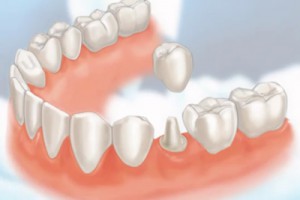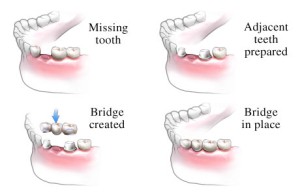Preventive Dentistry
Prophylaxis/Dental Cleaning | Periodontal Treatment | Pediatric Dentistry | Sealants | Nightguards and Athletic Mouthguards | Snoring/Sleep Apnea | Geriatric Dentistry
Crowns and bridges are used to restore teeth that are damaged, or replace a missing tooth or teeth. A crown, also known as a cap, is used to cover the entire damaged tooth. A crown can not only strengthen a tooth, but it can be used to improve a tooth’s appearance, shape and alignment.

Crowns may be recommended to:
A bridge is sometimes recommended to fill the space created by missing teeth. A bridge provides one or more artificial teeth that are cemented into place using the teeth on either side for support. This is an option for filling the space created by a missing tooth. A bridge replaces the missing tooth, both functionally and cosmetically. The materials used may be gold alloys, porcelain bonded to metal alloy, or all ceramic material made to match your natural tooth color. The choice of material depends on requirements for strength, wear, and/or esthetics.

Veneers are a dental procedure in which a covering is placed over the outside (visible area) of the tooth. They are usually only done to the part of the teeth that are visible when talking or smiling.
At least two appointments are needed because the veneers will be fabricated at a dental laboratory. At the first appointment the teeth are prepared, impressions taken, and the teeth are given a temporary covering. When the veneers are back from the laboratory, the temporaries are removed and the veneers are bonded to the teeth. The laboratory fabricated veneers are usually made using porcelain or pressed ceramic, and these materials will look natural and are very esthetic.
The advantage of veneers versus crowns is that much less tooth material is removed. Veneers may be recommended for teeth that have small fillings or small amounts of missing tooth structure if there is enough strong and stable tooth to support the veneer.

The Georgia Dental Association recommends seeing a patient as early as 1 year old. It starts with a visit to help answer any questions that the parent/parents may have. Our goal is to start developing a comfortable and lifelong dental home for our youngest of patients. Usually, the actual prophylaxis/dental cleaning is not usually performed until approximately age 3.
Routine Checkups/Exams can include some, but not all of these, based on the patient’s age and needs.
In order to provide nothing but the best to our patients, our office uses state-of-the-art technologies in all our procedures. These new technologies allow us to detect dental concerns at early stages, treat your dental issues with precision, and provide excellent, customized restorations. Our premium dental software system maximizes your time and our office efficiency. When you visit our office you can be confident that you are receiving the finest and most advanced in dental care.